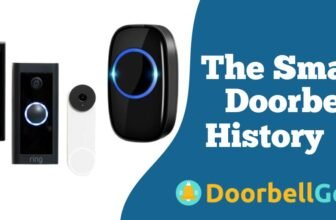Wireless doorbells started in the 1930s. A company called Nutone made the first one. It used radio waves to send a signal from the button to the bell. It did not need wires so it was easy to set up. The first versions had weak signals and short range. Even with problems they helped start new ideas for wireless doorbell work. Over time better parts made them work well. New models could reach farther and had more sounds. They also lasted longer with better batteries. People liked that they were easy to install. They also looked nice in many homes. Some let you change the sound and how loud it is. Others have cameras and smart features. You can see who is at your door using your phone. This helps keep your home safe. It also makes life easier for many people today.
The History Of Wireless Doorbell In 1930 to 1950
Nutone made the first wireless doorbell in the 1930s. It worked by using radio waves to send a signal from the button to the bell . so there was no need for wires. This made it easier to install wireless doorbell and gave people more choices in design. These early doorbells were not like the ones we use today—they had a short range, and other devices could block the signal. Still even with these problems it was an important step forward in the history of doorbells.
The Birth of Wireless Doorbells (1930s)
In the 1930s Nutone made the first wireless doorbell. It worked by using radio waves to send a signal from the button to the bell. So there was no need for wires. This made it easier to install and gave people more choices in design. These early doorbells were not like the ones we use today—they had a short range and other devices could block the signal. Still even with these problems it was an important step forward in the history of doorbells.
1. The Birth of Wireless Doorbells (1930s)
Wireless doorbells first appeared in the 1930s, introduced by an American company called NuTone. These early models worked by using radio waves to send a signal from the button to the bell, which meant no wires were needed. This was a new and exciting idea at the time. Because of their high price and modern design, they were mostly used in stylish, high-end homes. People liked how easy they were to install and how clean they looked on the wall. Still, they were not common and remained a rare feature in most houses.
2. Initial Challenges with Signal Strength (1930s)
In the beginning, wireless doorbells had a tough time working well. The signals were weak and didn’t travel far, so the button and bell needed to be close together. Even then, other electronics in the house—like radios or blenders—could mess with the signal. Sometimes, doorbells rang by mistake, or didn’t ring at all. These problems made early wireless systems unreliable, and not many people wanted to try something that didn’t work as well as a regular wired doorbell.
I. Early systems used AM signals, which were highly sensitive to noise and interference.
II. The power supply was unstable—some units ran on short-life batteries, adding maintenance worries.
III. Manufacturers didn’t yet have shielding to block electrical interference.
IV. Homeowners were frustrated by false rings or complete silence.
3. Limited Market Adoption (Late 1930s)
Back in the late 1930s, wireless doorbells were still new and seen as high-end gadgets. Only people in big cities or those with extra money could afford them. Most homeowners stuck with the wired models they already trusted. Even though middle-class families were starting to notice wireless options, they didn’t catch on quickly. The cost and performance made people think twice before switching from the wired systems they already had in place. Advertising for wireless doorbells mainly appeared in upscale magazines or catalogs.
I. Rural and suburban homes lacked access to the few stores that sold them.
II. Retailers often did not stock wireless units limiting visibility.
III. Consumers viewed them as experimental not everyday products.
4. Improved Signal Transmission (1940s)
During the 1940s, wireless doorbells started to improve. Manufacturers tested better radio frequencies and designed stronger antennas. Some models even used frequency modulation (FM), which made the sound clearer and reduced the chances of the bell ringing at the wrong time. These changes helped people trust the product more and enjoy a better user experience. The signal became more stable, which was a big step forward for making wireless doorbells a regular part of homes.
I. FM signals handled obstacles like walls better than AM signals.
II. Longer-range units were introduced, helping in larger homes or multi-room setups.
III. Companies started offering technical support and installation help to reduce user issues.
IV. Signal strength improvements laid the groundwork for multi-doorbell systems.
5. Radio Frequency Shifts and Better Technology (1940s)
To avoid signal issues from other electronics like radios and TVs, wireless doorbells in the 1940s started using different radio frequencies. This shift helped reduce interference, so the bell would only ring when it was supposed to. As the technology got better, these doorbells worked more reliably and over longer distances. People began to see them as more than just a fancy gadget—they were actually useful and could fit into everyday home life.
I. Dual-frequency doorbells were developed to prevent overlap with neighbors devices.
II. Manufacturers started using frequency filters and tuners to block unwanted signals.
III. These changes helped wireless doorbells work in multi-family housing like apartments.
IV. Better range allowed doorbells to be used at back entrances or garage doors too.
6. Popularity in New Homes and Apartments (1940s)
As more people moved into new homes and apartment buildings in the 1940s, wireless doorbells started to become a popular option. Many new places didn’t have pre-installed wiring for traditional doorbells, and installing wires later could be expensive or messy. Wireless systems were easy to put up, didn’t need drilling or rewiring, and worked right out of the box. This made them a smart pick for modern buildings, especially small homes and apartments where simple solutions were needed.
I. Builders started pre-installing compatible receivers into walls.
II. Wireless models appealed to landlords for easy maintenance and tenant upgrades.
III. Portable receivers let renters carry chimes room-to-room.
IV. Some doorbells were marketed directly to builders and real estate developers.
7. Rise in Sales Due to Convenience (1940s)
More people began choosing wireless doorbells in the 1940s simply because they were easier to use. Unlike wired versions, they didn’t need professional installation or tools. You could just place the button, plug in the receiver, and it worked. As housing expanded and many homes didn’t come with wired systems, these wireless models looked like a smart choice. The fact that they saved time and avoided hassle helped boost their popularity and pushed sales higher.
I. DIY culture grew post-war and people liked gadgets they could install on their own.
II. Home improvement stores began stocking them as a home upgrade product.
III. Womens magazines featured them as family-friendly tech for modern homes.
IV. Battery-powered units gained better shelf-life reducing the need for frequent changes.
8. The Luxury Appeal Fades by Late 1940s
By the end of the 1940s wireless doorbells were not just for wealthy families anymore. The technology had come a long way—better signals, easier setup, and lower prices. Middle-class families started to see them as a practical upgrade for their homes. What used to be seen as a luxury gadget became a helpful everyday item. As more people bought them they became a regular part of home life instead of something special only a few could afford.
I. Standardized models hit the mass market, driving costs down.
II. Warranty and return policies boosted consumer confidence.
III. Bulk sales to housing developments made doorbells part of new-home packages.
IV. Wireless doorbells began being seen as modern essentials, not luxury add-ons.
Wireless Doorbells: After 1950
Wireless doorbells have come a long way. They started simple but over the years got smaller, louder and easier to use. Today’s models have smart features like video, motion alerts and even solar power. They don’t just ring anymore. They help you see who’s at the door, talk to them, and feel more secure at home.
1. 1950s – Better Technology and Smaller Size
In the 1950s, wireless doorbells got better and smaller. New models used transistors instead of vacuum tubes, which made them cheaper and more energy-efficient. Signals became stronger, and the chimes were louder and clearer. These changes helped more people start using wireless doorbells in their homes.
I. Transistors reduced heat output making doorbells safer and longer-lasting.
II. Smaller size meant easier wall mounting and less space taken in the home.
II. Lower power needs allowed use of smaller batteries saving costs.
IV. Reliability increased with fewer false rings and missed alerts.
V. Manufacturers started advertising doorbells as modern home upgrades.
1960s – Custom Channels to Avoid Interference
As more homes used wireless electronics, signal problems became common. Doorbells in the 1960s added switchable channels so people could avoid interference from nearby devices. This made them more reliable, especially in apartment buildings or close neighborhoods.
I. Channel customization reduced overlap with baby monitors, radios, and garage openers.
II. Some models came with printed guides to help pick the right frequency.
III. Apartment buildings started recommending certain brands with channel options.
IV. Added confidence for users who had previously returned faulty products.
V. Increased product reputation helped grow wireless doorbell sales.
1970s – More Sounds and Stylish Designs
Doorbells in the 1970s began offering different chime sounds. People could choose tones they liked. Designs also became more stylish to match home décor, making the doorbell not just useful but also nice to look at.
I. Sound variety included melodies and seasonal chimes for holidays.
II. Color choices expanded to match interior paint and wallpaper trends.
III. Marketing targeted homeowners interested in modern décor.
IV. Some models had wood grain finishes or chrome accents.
V. Doorbells became a statement piece instead of a hidden device.
1980s – Lower Prices and Easy Setup
Cheaper electronic parts and mass production helped make wireless doorbells more affordable in the 1980s. They were sold in many stores and came with simple setup steps, which made them great for people who liked DIY home projects.
I. Doorbells came with step-by-step instruction booklets.
II. Adhesive-backed buttons eliminated the need for screws or drills.
III. Batteries became more efficient needing fewer replacements.
IV. Retail displays promoted them as install in minutes products.
V. Price drops allowed bulk sales and gift purchases for new homeowners.
1990s – New Features for Safety and Access
In the 1990s doorbells started adding extra features like motion sensors and flashing lights for people who have trouble hearing. Some also had volume controls and longer range. These changes helped improve home safety and made doorbells more accessible.
I. Flashing lights helped deaf or hard-of-hearing users respond faster.
II. Some models had backlit buttons for better visibility at night.
III. Doorbells with voice alerts were released for added clarity.
IV. Long-range transmitters worked in larger houses or multi-story buildings.
V. Accessibility became a focus in product development and advertising
2000s – Video and Two-Way Talk
The 2000s brought a big change with video doorbells. Brands like Ring and SkyBell offered models with built-in cameras and microphones. People could see and talk to visitors from their phones. These doorbells used Wi-Fi and special apps for control.
I. Infrared night vision allowed users to see clearly in the dark.
II. Cloud video storage let users review visitor history anytime.
III. Motion zones could be set to monitor specific areas.
IV.Two-way talk helped users communicate with delivery drivers or guests.
V. These doorbells began to replace home intercom systems.
2010s – Smart Home Integration
Doorbells in the 2010s became part of smart home systems. They could work with Alexa, Google Assistant and other voice tools. They included cloud storage, motion recording, night vision, and alerts on your phone, helping people feel safer at home.
I. Users received real-time alerts on their phones with visitor snapshots.
II. Smart doorbells synced with home security systems and smart locks.
III. Scheduling features let users silence the bell during certain hours.
IV. Integration with hubs made full-home automation possible.
V. AI started to filter motion events for better accuracy.
2020s – Solar Power and Smart AI Features
New models use solar panels to reduce battery changes and help the environment. AI-powered motion detection can now tell the difference between people, pets, and vehicles. Many doorbells now offer HD or even 2K video and longer battery life making them more helpful and modern. Everyone wants to feel secure in their own home. Make your security smart doorbells can help you. As the doorbell has option to see who is in the front door and to speak with the person
I. Some doorbells now support facial recognition to identify frequent visitors.
II. Solar charging keeps the system running even in remote areas.
III. Voice commands allow hands-free operation and visitor interaction.
IV. Doorbells can now send customized alerts.
V. Privacy features like masked video zones and encrypted storage are included.
Conclusion
The history of smart doorbells shows how much technology has grown over time. It started with basic wired doorbells in the early 20th century then moved to wireless systems in the mid-century. Each upgrade made doorbells more useful and easier to use. A big change came in the 21st century when smart doorbells became popular. These new models added video monitoring, motion detection, two-way audio, and smart home connections. They changed how people protect and manage their homes. Today smart doorbells help keep homes safe and make daily life easier and more connected. As technology keeps improving . We can expect even smarter features that boost home safety and user comfort.






